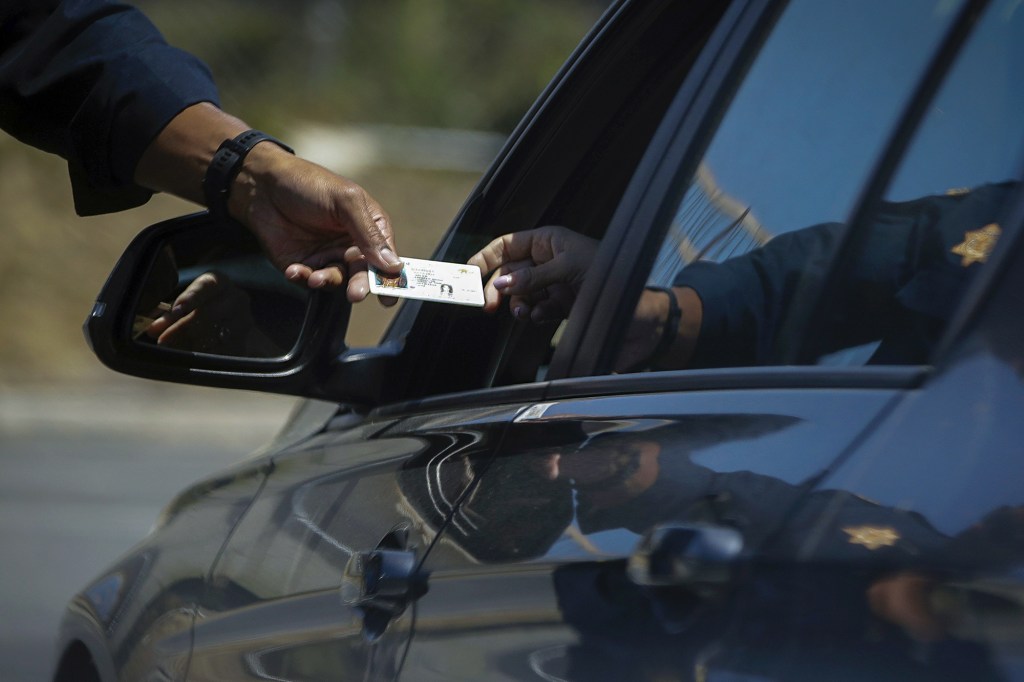
By Debra Brennan | CalMatters
Almost everyone gets nervous during a traffic stop, but people with disabilities also worry about whether an officer understands their condition or could misinterpret their symptoms.
An Inland Empire lawmaker wants to make it easier for Californians with disabilities to deal with police traffic stops, by enabling drivers to present law enforcement with special blue envelopes containing information about their vehicle and disability accommodations.
San Diego introduced a blue envelope program in 2023, and Riverside and San Bernardino rolled theirs out last year. Several East Coast states and Colorado also use blue envelopes.
State Sen. Rosilicie Ochoa Bogh, a Redlands Republican, introduced a bill in February to expand the program throughout California.
“It provides preparation and awareness on the public safety side of it but also accommodates and eases the fear and the panic that our constituents with disabilities may have,” Ochoa Bogh said. “It deescalates the potential of police stops in our state.”
A traffic stop under the program could go something like this: an officer stops the driver and asks for identification. The driver asks to present a blue envelope, which contains copies of the driver’s license, insurance and registration, and possibly relevant information about the person’s disability.
The blue envelope signals the officer to slow down and be patient, and it makes the driver more comfortable interacting with law enforcement.
But critics have concerns about privacy and say the bill doesn’t include resources needed to make sure the program rolls out effectively.
“It would need to be a quality program, and this bill falls short,” said Beth Burt, executive director of the Autism Society Inland Empire.
Ochoa Bogh’s bill calls for the Department of Motor Vehicles to print and distribute the blue envelopes with safety and communication tips for officers and drivers. They would also provide blank spaces where drivers can write in their needs, accommodations and emergency contact information.
The DMV would offer the blue envelopes upon request. Ochoa Bogh acknowledged some people don’t want to disclose their disabilities; no one would be required to participate.
The bill goes to a Senate Transportation Committee hearing on April 28.
During a traffic stop, some people with disabilities may react in ways that officers could read as signs of guilt or defiance.
For instance, Ochoa Bogh said, people with cerebral palsy may have tremors that could be misconstrued as nervous or guilty behavior. Burt said officers sometimes mistake their shaking symptoms for driving under the influence.
People with limited verbal abilities “may take time to process the information and articulate an answer” to an officer’s questions, Ochoa Bogh said, while those with physical disabilities may take longer to get out of a vehicle.
For drivers with autism, a traffic stop can worsen communication difficulties and exaggerate stims, which are reflexive, repetitive movements, and other anxious body language.
Miscommunication over disabilities has led to tragedy. Last year San Bernardino County Sheriff’s Deputies shot and killed a 15-year-old Apple Valley boy who had autism, after he charged at one of them with a garden tool. News reports at the time said it was unclear if the deputies knew he had autism, but the family filed a lawsuit alleging civil rights violations.
That’s why Burt thinks a statewide blue envelope program should apply to all public safety encounters, including those involving pedestrians, cyclists and transit riders, not just traffic stops. And she said there should be training to make sure everyone is on the same page.
Officers need to learn how to communicate with people with disabilities and how to calm down tense situations, she said. People with disabilities and their families must know how to react safely during a traffic stop. And they need to know what the program does and doesn’t do.
“One of our concerns is that families will think it’s a get-out-of-jail-free program; it’s okay that I run a stoplight or get caught speeding because I have a blue envelope,” she said.
Burt said her organization worked with San Bernardino County law enforcement and the Inland Regional Center to build the county’s program, spending $50,000 to produce merchandise, including envelopes, bracelets, key chains, lanyards, stickers and seat belt covers to help people communicate about their disabilities. They also provided written materials in multiple languages.
Burt said she appreciates Ochoa Bogh’s intentions, but a successful blue envelope program takes more time and resources than her bill would provide.
“When you’ve got a good quality program, we’ve seen what it does for adults with autism and other disabilities,” she said. “They feel safe and heard, versus a free program where you would just put the envelopes out with the DMV.”
Last year Assemblymember Kate Sanchez, a Rancho Santa Margarita Republican, introduced a similar bill to create a statewide blue envelope program, which would have cost an estimated $8.3 million. That bill failed in committee.
This time Ochoa Bogh is calling for community organizations to help cover the cost of producing and distributing the blue envelopes. She said creating a statewide system would provide consistency for people traveling with disabilities.
“This is a framework that local jurisdictions can work with and modify, so that no one is reinventing the wheel and that there is some commonality between adjacent counties,” she said. “It deescalates, it educates and empowers everybody to have a more amicable interaction.”
Originally Published:



